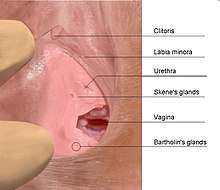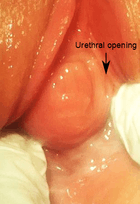Skene's gland
In female human anatomy, Skene's glands or the Skene glands (/skiːn/ SKEEN; also known as the lesser vestibular glands, paraurethral glands,[1] or homologous female prostate) are glands located on the anterior wall of the vagina, around the lower end of the urethra. They secrete a fluid that helps lubricate the urethral opening and are surrounded with tissue that swells with blood during sexual arousal.
| Skene's gland | |
|---|---|
 | |
| Details | |
| Precursor | Urogenital sinus |
| Identifiers | |
| Latin | glandulae vestibulares minores |
| TA | A09.2.01.017 |
| FMA | 20083 |
| Anatomical terminology | |
Structure and function
The Skene's glands are located in the general area of the vulva, on the anterior wall of the vagina around the lower end of the urethra. The Skene's glands are homologous with the prostate gland in males, containing numerous microanatomical structures in common with the prostate gland, such as secretory cells.[2][3] Skene's glands are not, however, explicit prostate glands themselves. The two Skene's ducts lead from the Skene's glands to sites on the surface of the vulva, to the left and right of the urethral opening, from which they are structurally capable of secreting fluid.[2] Although there remains debate about the function of the Skene's glands, one purpose is to secrete a fluid that helps lubricate the urethral opening, possibly contributing antimicrobial factors to protect the urinary tract from infections.[3]
The origin and production site of female ejaculation has not been proven.[4] It has been postulated that the Skene's glands are the source of female ejaculation.[4][5] Because the Skene's gland and male prostate act similarly in terms of prostate-specific antigen (PSA), which is an ejaculate protein identically produced in males, and in terms of prostate-specific acid phosphatase, this led to a trend of calling the Skene's glands the female prostate.[3][5] Female ejaculate, which may emerge during sexual activity for some women, especially during female orgasm,[4] contains biochemical markers of sexual function like human urinary protein 1[6] and the enzyme PDE5, whereas women without the gland had lower concentrations of these proteins.[7] When examined with electron microscopy, the Skene's and prostate glands show similar secretory structures.[2]
It has been demonstrated that a large amount of fluid can be secreted from these glands when stimulated from inside the vagina.[8][9] Some reports indicate that embarrassment regarding female ejaculation, and the debated notion that the substance is urine, can lead to purposeful suppression of sexual climax, and lead women to seek medical advice and even undergo misadvised surgery to "stop the urine".[10]
Clinical significance
Disorders of or related to the Skene's gland include:

- Skene's duct cyst[13]
- Trichomoniasis:[14] The Skene glands (along with other structures) act as a reservoir for Trichomonas vaginalis. This is why topical treatments are not as effective as oral medication.[15]
Inflammation of the Skene's glands and Bartholin glands may appear similar to cystocele.[16]
History
While the glands were first described by the French surgeon Alphonse Guérin (1816–1895), and in 1872 by Regnier de Graaf,[17] they were named after the Scottish gynaecologist Alexander Skene, who wrote about it in Western medical literature in 1880.[18][19][20] In 2002, Skene's gland was officially renamed to female prostate by the Federative International Committee on Anatomical Terminology.[21]
See also
References
- "paraurethral glands" at Dorland's Medical Dictionary
- Zaviacic, M; Jakubovská, V; Belosovic, M; Breza, J (2000). "Ultrastructure of the normal adult human female prostate gland (Skene's gland)". Anatomy and Embryology. 201 (1): 51–61. doi:10.1007/PL00022920 (inactive 20 August 2019). PMID 10603093.
- "A female prostate?". Berkeley Wellness, University of California at Berkeley. 18 April 2013. Retrieved 7 May 2017.
- Greenberg, Jerrold S.; Bruess, Clint E.; Oswalt, Sara B. (2014). Exploring the Dimensions of Human Sexuality. Jones & Bartlett Publishers. pp. 102–104. ISBN 978-1449648510. Retrieved 30 October 2014.
- Bullough, Vern L.; Bullough, Bonnie (2014). Human Sexuality: An Encyclopedia. Routledge. p. 231. ISBN 978-1135825096. Retrieved 30 October 2014.
- Zaviacic M, Danihel L, Ruzicková M, Blazeková J, Itoh Y, Okutani R, Kawai T (March 1997). "Immunohistochemical localization of human protein 1 in the female prostate (Skene's gland) and the male prostate". Histochem J. 29 (3): 219–27. doi:10.1023/A:1026401909678. PMID 9472384.
- Jones, Nicola (3 July 2002). "Bigger is better when it comes to the G-Spot". New Scientist.
- Castleman, Michael (2 January 2014). "Female Ejaculation: What's Known and Unknown". Psychology Today. Sussex Publishers, LLC. Retrieved 8 May 2017.
- Heath D (1984). "An investigation into the origins of a copious vaginal discharge during intercourse: "Enough to wet the bed" – that "is not urine"". J. Sex Res. 20 (2): 194–215. doi:10.1080/00224498409551217.
- Chalker, Rebecca (2002). The Clitoral Truth: The secret world at your fingertips. New York: Seven Stories. ISBN 1-58322-473-4. Retrieved 3 November 2013.
- Miranda EP, Almeida DC, Ribeiro GP, Parente JM, Scafuri AG (2008). "Surgical Treatment for Recurrent Refractory Skenitis" (PDF). TheScientificWorldJournal. 8: 658–60. doi:10.1100/tsw.2008.92. PMC 5848640. PMID 18661053.
- Gittes RF, Nakamura RM (May 1996). "Female urethral syndrome. A female prostatitis?". Western Journal of Medicine. 164 (5): 435–38. PMC 1303542. PMID 8686301.
- McNeeley, S. Gene (December 2008). "Skene's duct cyst". Merck Manuals Online Medical Library. Merck. Retrieved 5 March 2010.
- Petrin D, Delgaty K, Bhatt R, Garber G (1998). "Clinical and Microbiological Aspects of Trichomonas vaginalis". Clinical Microbiology Reviews. 11 (2): 300–317. doi:10.1128/CMR.11.2.300. PMC 106834. PMID 9564565.
- Harvard Medical School Health Topics A-Z. Harvard Health Publications. 2017 – via Credo Reference.
- "Cystoceles, Urethroceles, Enteroceles, and Rectoceles - Gynecology and Obstetrics - Merck Manuals Professional Edition". Merck Manuals Professional Edition. Retrieved 6 February 2018.
- de Graaf, Regnier (1872). De Mulierum Organis Generationi Inservientibus (in Latin). Leiden.
- Skene, A (April 1880). "The anatomy and pathology of two important glands of the female urethra". The American Journal of Obstetrics and Diseases of Women and Children. 13: 265–70.
- Skene's glands at Who Named It?
- Skene's ducts at Who Named It?
- Flam, Faye (15 March 2006). "Health: Gee, women have ... a prostate?". The Seattle Times. Retrieved 27 September 2015.
External links
| Look up skene's gland in Wiktionary, the free dictionary. |
- Davì G, Asta G, Lagalla R, Midiri M, Mercadante G (1999). "Skene's gland pseudocysts. An occasional finding with computed tomography and ultrasound". La Radiologia Medica. 98 (4): 314–16. PMID 10615378.
- Radiology images of the Skene's gland
- Jones N (3 July 2002). "Bigger is better when it comes to the G spot". New Scientist.
- Geddes L (20 February 2008). "Ultrasound nails location of the elusive G spot". New Scientist.
- Gravina GL, Brandetti F, Martini P, Carosa E, Di Stasi SM, Morano S, Lenzi A, Jannini EA (March 2008). "Measurement of the thickness of the urethrovaginal space in women with or without vaginal orgasm" (PDF). J Sex Med. 5 (3): 610–18. doi:10.1111/j.1743-6109.2007.00739.x. hdl:2108/8798. PMID 18221286.